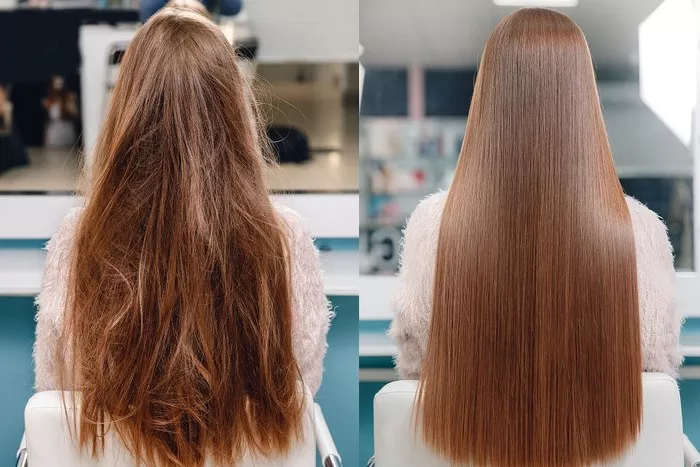Split ends are a common hair concern that many people experience at some point. They occur when the protective outer layer of the hair cuticle wears away, leading to fraying or splitting at the ends. This article will explore the causes of split ends, the effectiveness of various treatments, and preventative measures to maintain healthy hair.
What Are Split Ends?
Definition of Split Ends
Split ends, or trichoptilosis, are damaged hair strands that have split into two or more segments. They can occur at any length and affect all hair types. The most common appearance of split ends is a frayed, wispy look at the tips of the hair.
Types of Split Ends
Classic Split Ends: The most common type, where the hair splits into two or more strands at the tip.
Tree Split Ends: This type has a more dramatic split that resembles a tree branch, with multiple splits branching out from one point.
Feather Split Ends: These are softer splits that create a feather-like appearance at the end of the hair.
Causes of Split Ends
Understanding the underlying causes of split ends is crucial for effective prevention and treatment. Here are some of the most common causes:
Lack of Moisture
Dry hair is more prone to splitting. Environmental factors, such as humidity and exposure to heat, can dehydrate hair, leading to split ends.
Heat Styling
Frequent use of heat-styling tools like blow dryers, curling irons, and straighteners can weaken the hair shaft. The high temperatures strip moisture from the hair, making it brittle and susceptible to splitting.
Chemical Treatments
Dyeing, perming, or relaxing hair can damage the cuticle and lead to split ends. Chemicals alter the hair structure, making it more fragile.
Physical Damage
Rough handling of hair, such as aggressive brushing or using harsh hair ties, can contribute to split ends. Additionally, exposure to environmental elements like sun, wind, and pollution can weaken hair.
Poor Hair Care Routine
Inadequate hair care practices, such as not using conditioner or failing to trim hair regularly, can lead to split ends.
See Also: Does Longer Hair Look Thinner? Unraveling the Myths and Facts
Can Split Ends Be Repaired?
The Reality of Repairing Split Ends
The short answer is that split ends cannot be fully repaired once they have occurred. The damage is irreversible, as the split hair shaft cannot be fused back together. However, various methods can help improve the appearance of split ends and prevent further damage.
Trimming
The most effective way to deal with split ends is to trim them off. Regular haircuts can remove damaged ends and prevent splits from traveling further up the hair shaft. Experts recommend getting a trim every 6 to 8 weeks, depending on hair length and condition.
Deep Conditioning Treatments
Deep conditioning treatments can help restore moisture to dry hair, making it more resilient. Ingredients such as oils, proteins, and humectants can penetrate the hair shaft and provide hydration, reducing the likelihood of further splits.
Leave-in Conditioners and Oils
Using leave-in conditioners and natural oils (like argan or coconut oil) can help protect the hair from damage and improve its overall health. These products create a barrier that seals moisture and minimizes the appearance of split ends.
Bond Rebuilding Treatments
Professional treatments, such as bond builders (e.g., Olaplex), can strengthen the hair by repairing broken bonds within the hair structure. While these treatments don’t “fix” split ends, they can improve the overall integrity of the hair and reduce future damage.
Heat Protection
If you use heat-styling tools, applying a heat protectant spray can minimize damage. These products form a protective layer around the hair, reducing moisture loss and preventing split ends.
Gentle Hair Care
Adopting gentle hair care practices can prevent split ends from forming. Use a wide-tooth comb to detangle wet hair and avoid harsh rubbing with towels. Opt for soft hair ties to reduce physical damage.
Prevention Tips for Split Ends
Preventing split ends is far easier than repairing them. Here are some effective strategies:
Moisturize Regularly
Incorporate a moisturizing shampoo and conditioner into your hair care routine. Use deep conditioning masks weekly to keep hair hydrated.
Limit Heat Exposure
Try to reduce the frequency of heat styling. When necessary, use lower heat settings and always apply a heat protectant.
Choose Hair Products Wisely
Select sulfate-free shampoos and products free from harsh chemicals. Look for formulas that promote moisture and repair.
Protect Hair from Environmental Damage
Wear a hat in the sun, avoid chlorinated water, and use products that provide UV protection to shield your hair from environmental stressors.
Healthy Lifestyle Choices
A balanced diet rich in vitamins and minerals contributes to healthy hair. Ensure you’re getting enough protein, vitamins A, C, D, E, zinc, and omega-3 fattyacids.
Conclusion
While split ends cannot be repaired once they occur, proactive measures can help maintain healthy hair and minimize damage. Regular trims, deep conditioning treatments, and gentle hair care practices are essential to keep your hair looking vibrant and healthy. By understanding the causes of split ends and implementing effective prevention strategies, you can enjoy beautiful, resilient hair for years to come.
You Might Be Interested In
- Does Long Hair Make You Look Older? Debunking the Myths
- Does Your Hair Grow Quicker if You Cut It? Uncover the truth
- Does Cutting Hair Short Make It Grow Thicker? Learn the truth


